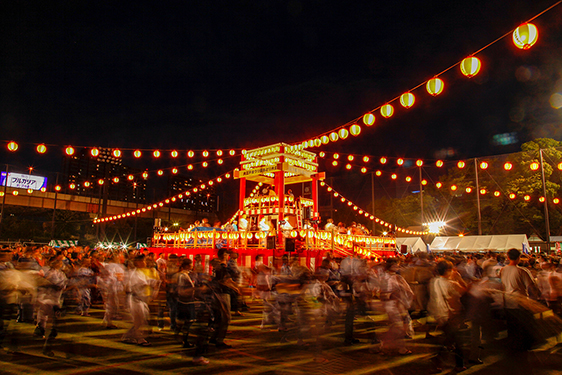Obon, also known as Bon, is one of Japan’s most significant and spiritually meaningful festivals. Held annually in mid-August (or July in some regions), Obon Matsuri is a time when Japanese people honour the spirits of their ancestors, welcoming them back to the physical world for a few days of reunion with their living descendants. Rooted in Buddhist and Shinto beliefs, Obon is not only a period of deep reflection and remembrance but also a time of vibrant cultural celebrations, family gatherings, and community events.
This article explores the history, traditions, and significance of Obon Matsuri, providing a glimpse into how the Japanese people connect with their cultural and spiritual heritage through this beloved festival.

The History and Origins of Obon
Obon has its roots in Buddhist traditions, particularly the story of Mokuren, a disciple of the Buddha. According to the legend, Mokuren used his spiritual powers to look into the afterlife and discovered that his deceased mother was suffering in the Realm of Hungry Ghosts, a place where souls endure great hunger and thirst as punishment for their earthly sins. Distressed, Mokuren sought the Buddha’s advice, who instructed him to offer food and prayers to Buddhist monks at the end of their rainy season retreat. Upon doing so, Mokuren’s mother was released from her suffering, and Mokuren danced with joy. This dance, known as Bon Odori, became a central feature of the Obon festival.
Over the centuries, Obon evolved into a widespread practice across Japan, blending Buddhist rituals with Shinto beliefs in ancestral spirits (kami). The festival has become a time when families reunite, clean the graves of their ancestors, and participate in various traditional activities that honour the dead.
Key Traditions and Customs
1. Mukaebi and Okuribi: Welcoming and Sending Off the Spirits
Obon typically begins with Mukaebi (welcoming fires), small bonfires or lanterns lit at the entrances of homes to guide the spirits of ancestors back to the world of the living. Families prepare a special altar with offerings of food, flowers, and incense to welcome the spirits home.
At the end of Obon, Okuribi (farewell fires) are lit to send the spirits back to the afterlife. In Kyoto, the famous Daimonji festival marks this occasion with the lighting of enormous bonfires on the mountains surrounding the city, forming the shape of kanji characters that symbolize the spirits’ return to the spirit world.
2. Bon Odori: The Dance of Joy
Bon Odori is a traditional dance performed during Obon, symbolizing the joy and gratitude of the living for the sacrifices made by their ancestors. The dance varies by region, with each area having its unique style, music, and costume. In some places, participants wear yukata (light summer kimonos) and dance in a circle around a yagura (a raised platform where musicians play traditional instruments like taiko drums).
The dance is open to everyone, and it’s common for entire communities to gather in public squares or temples to dance together, creating a festive atmosphere that contrasts with the sombreness of the rituals.
3. Tōrō Nagashi: Floating Lanterns
Tōrō Nagashi is another poignant aspect of Obon, where paper lanterns are lit and set afloat on rivers, lakes, or the sea to guide the spirits back to the afterlife. The flickering lights of the lanterns drifting on the water create a beautiful and serene scene, symbolizing the souls’ peaceful return to the otherworld.
This practice is especially famous in Hiroshima, where thousands of lanterns are floated on the Motoyasu River near the Peace Memorial Park on August 6th to commemorate the victims of the atomic bomb and send their spirits to rest.
Modern-Day Obon: A Time for Reflection and Celebration
Today, Obon remains a deeply spiritual time for Japanese people, but it also has taken on aspects of a family reunion and summer festival. Many people living in urban areas travel back to their hometowns to be with their families, clean the graves of their ancestors, and participate in local festivities. Towns and cities across Japan hold Obon festivals, featuring Bon Odori, food stalls, games, and fireworks.
While Obon is a national holiday, the specific dates and customs can vary depending on the region. For instance, Obon is celebrated in mid-August in most parts of Japan, but in some areas like Tokyo and Okinawa, it’s observed in mid-July.
For tourists, Obon offers a unique opportunity to experience Japanese culture and traditions firsthand. Visitors can participate in Bon Odori dances, watch Tōrō Nagashi ceremonies, and witness the community spirit that defines this festival. It’s a time to reflect on the universal themes of life, death, and remembrance while enjoying the warmth and hospitality of Japanese communities.
Conclusion
Obon Matsuri is more than just a festival; it’s a sacred time that connects the living with the dead, the present with the past. It’s a reminder of the importance of family, respect for ancestors, and the continuity of life. Whether you’re observing the solemn rituals or joining in the joyful dances, Obon provides a profound insight into the spiritual and cultural heart of Japan.
For anyone visiting Japan during this time, participating in Obon offers a deeply enriching experience, filled with tradition, reflection, and community celebration.










